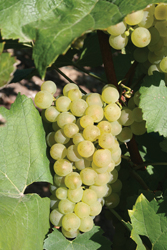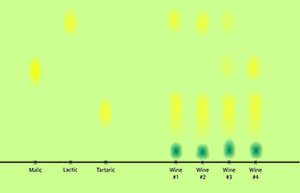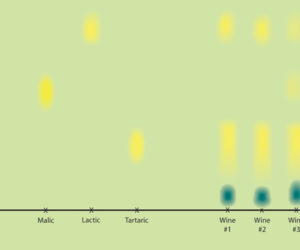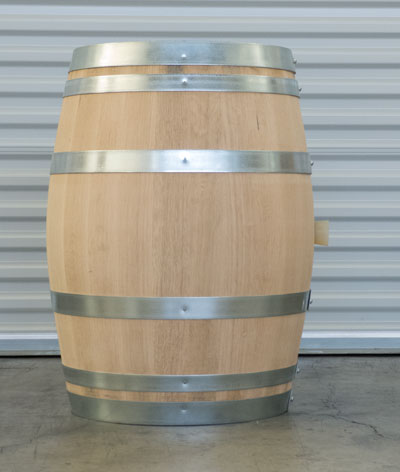
I have 7 gallons (26 L) of 2009 Chardonnay made from home-grown grapes. This was my first year of production from these vines and I did not use oak or MLF. Fermentation was normal and I clarified with bentonite, then cold stabilized. I recently tested it at 3.16 pH, 0.53 TA and 40 ppm SO2 and thought it was ready to bottle. However, a chilled sample (40 °F/4 °C) tasted slightly bitter and a little too acidic. Is it too late to try MLF and do you think it might help? Is it too late to add some oak chips and would that help its character?
Garth Brown
Alpine, California
Before you set about making any major changes to this wine, make sure that when you taste you are not tasting a sample that has a lot of dissolved carbon dioxide gas in it. Tiny bubbles can be refreshing in a white or pink wine, but they can contribute to a sense of sharpness and a perception of increased acidity, essentially because dissolved carbon dioxide gas (+ water=carbonic acid) will actually decrease the pH of the wine. To de-gas a tasting sample, simply seal up about 100 mLs in a small jar or bottle and shake vigorously, then release the seal on the container, “burping” your wine of its dissolved gas. Repeat two or three times or until the wine isn’t foaming so much anymore. Then pour into a glass and swirl, sip and spit.
Also, try tasting at a higher temperature. Anything below 45 °F (7 °C) can increase the perception of acidity.
You are doing a lot of things right to get that bright fruit to show through, namely racking, cleaning the wine up with bentonite and cold stabilizing it. Looking at your numbers though, I am thinking that your pH is a probably a little “bitey” (as my New Zealand winemaking friends might say).
Your FSO2 is also a little bit too high — at a pH of 3.16, your added sulfites will be very effective (more in the molecular and antimicrobial form) and so you could probably get away with bottling at FSO2 of 25 ppm even. Too much SO2 can actually give your wine a burning sensation on the nose and can really deaden the fruit. In red wines, too much SO2 at bottling can actually bleach color.
Adding a little bit of toasty, vanilla-y oak might help your wine taste a little bit more like Chardonnay and would be an easy addition to do. If you can, do small bench trials first (soak an oak chip in a baby food jar full of your wine for example) to see if you like the treatment before you subject your whole batch of wine to it. As always with oak (and most additives), start conservatively because you can always add oak, and it’s almost impossible to remove.

Taking your wine through MLF at this point would be near impossible because you’ve got two major counter-indications, namely your low pH (bacteria thrive only at high pHs) and your high sulfite level (no ML bug will survive at that level). To get MLF to push through, you’d have to take down the acidity with calcium carbonate and try to “age out” the sulfites (FSO2 will eventually disappear with time, though your total will remain the same) or add hydrogen peroxide to the wine to bind up the sulfites. In my experience, these are two pretty extreme “interventionist” steps that would really mess with the aromatics and the mouthfeel.
So what to do? I think your two best bets are these: 1) blending and/or 2) residual sugar adjustment. If you have a white wine (or can make one) with a higher pH that you can blend with this bitey little number, the end result wine might be something you’d be proud of. If you don’t happen to have a handy 7-gallon (26-L) batch of mL-complete Chardonnay on hand, an easier tweak (note I’m not saying “fix”) is to trick your taste buds to enjoy the wine a little more and counterbalance some of that acidity with a little residual sugar (RS). Sweetness will directly counteract the high acidity on your taste buds and will probably improve the mouthfeel by increasing the sensation of roundness in the wine. For an acid level this low, I’m thinking you might want to add 0.30–0.50%, depending on how sweet (or not) you like your wines. You can use grape-juice concentrate (buy through a home winemaking supply source, don’t get Welch’s from the store), table sugar or even honey to sweeten, whatever you desire.
Anytime there’s over about 0.20% residual sugar in a wine (and especially if the pH is higher, which encourages microbial growth too) you run the risk of ambient microbes eating that sugar and turning it into carbon dioxide and making your wine fizzy and cloudy. Though because your pH is so low and FSO2 is so high your re-fermentation risk is lowered, I still think it’s a good idea to be careful. If you decide to go this route, do bench trials to figure out how much sugar tastes good and be sure you sterile filter (0.45 nominal pore size) before you bottle
After moving to the Philippines, I was impressed with the wide variety of fruits at my disposal and the possibility of making wines. I worry, though, because many of the wine musts have high acidity and I am a novice in this endeavor. Are there any fruits that are taboo in country winemaking? What tests should I do to ensure nobody becomes ill from my wines?
Larry Cummins
Negros Oriental, Philippines
I wouldn’t worry too much about anyone getting sick from your wines as long as the water you use is clean and the alcohol is above 10%. As a professor of enology at UC-Davis used to always say in class, “No human pathogen can survive in wine.” Essentially this means that since wine (and she was talking about a typical grape wine here, by the way) has such a high level of alcohol and acid (typically 11%+ and 5.0 g/L+ respectively), no microbe disease agent that can harm people would be able to survive in that kind of hostile environment. So I wouldn’t worry about giving your friends food poisoning as long as your beverages have those kinds of statistics too.
You might be concerned, however, with the palatability and the practicality of turning some of your more exotic fruits into wines. Fruit wines (or “country wines” as they’re sometimes called) can be a challenge to make because of the raw material itself and often need to be blended with other juices (or diluted with water and/or grape juice) to ferment to the alcohol level and acidity we’re typically looking for. Citrus fruits, for example, just have far too much acid and far too little sugar to ferment nicely to a wine on their own. No wine yeast would enjoy that environment nor would you enjoy the final result.
Then there are the biological/physiological challenges many fruits present. Quinces have a lot of pectin which makes them tend to be hazy (see the last question and answer about pectin hazes). Fruits like peaches or other soft stone fruits ferment down into a big sludgy gloppy mess, which, if you’re not careful to stir often enough, can produce hydrogen sulfide due to lack of oxygen to the yeast. In the case of something like a coconut, I’d be wary of the high fat content and would not even attempt that one.
Fruits other than grapes also can lack the necessary amino acids and micronutrients that wine yeast need to conduct a healthy fermentation and must therefore be carefully supplemented with a yeast nutrient mix. There are many, many reasons why winemakers think “grapes” when we think “wine.” These little grapey nuggets of sugar, acid, water, tannin and aromatic compounds simply are nature’s most practical and balanced raw material for winemaking.
So what’s a fruit-loopy winemaker to do? I suggest strategically blending your exotic esoterica with some variety of grape juice concentrate, using a pectolytic enzyme in the juice or must stage, and carefully adjusting sugar and acidity as needed before fermentation to achieve the winemaking style (alcohol level and acid level) you are looking for. That way you’ll get the flavor and fun of your jack fruit, pineapples or bananas (or whatever fruit you’ve got!) plus the biological “backup” of grapes.
When you choose a concentrate, however, try to pick a concentrate that makes sense for the fruit wine you want to blend it with. For example, some folks making blueberry or blackberry wine tend to buy Zinfandel or Cabernet Sauvignon concentrate. And on the other hand, you will probably want to use a neutral white Vitis vinifera concentrate such as Chardonnay, Sauvignon Blanc or even Thompson Seedless to give yourself a nice backdrop against which to show off your tropical treasures.






